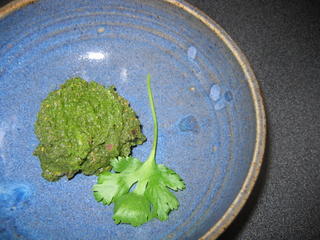Food in the News
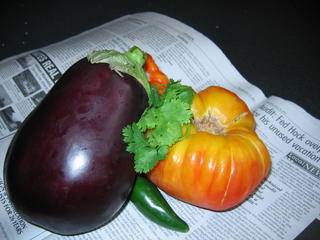 I just happened to notice a few news items this week, and thought I would share them with the readers out there in foodblogland.
I just happened to notice a few news items this week, and thought I would share them with the readers out there in foodblogland.
First Lady Picks First Woman Chef
Laura Bush has chosen a woman to be the new White House Executive Chef. Cristeta Comerford, a naturalized citizen from the Philippines, was promoted to the position of executive chef from within the staff of former Executive Chef Walter Scheib III, who as her mentor, was thrilled to see his protege step into his place.
While Women Chefs and Restauranteurs might smugly take some credit for the appointment of the first female White House chef, since they sent a letter to the First Lady, asking that she hire a female chef to serve as a role model to women in the culinary arts, none of the women suggested by the organization were interested in the position, which pays much less than top chefs can make working in the private sector.
But, hey–as far as I am concerned–it is still a reason to celebrate. Besides, the new chef lives with her family in my old neighborhood–Columbia, Maryland, so I feel like I am celebrating the success of one of my neighbors.
Vat-Grown Meat A Closer Possibility
Remember that little article I linked to in my “Meat Comes From Animals: Deal With it Or Eat Vegetables” rant that was about growing meat from cloned cells in a laboratory?
Well, the same researchers are in the news again, because of a paper they recently published in the journal, Tissue Engineering (sounds like scintillating reading, doesn’t it?), and this time, the story isn’t just being reported by a few outlets. It is being picked up here, there, and everywhere, with reporters putting the spin on whether or not this will pose an ethical dilimma for vegetarians.
If no animal died to produce it, is it still a bad thing to eat meat?
While the idea of vat-growing meat doesn’t gross me out like it does some people, I noticed that what they are talking about growing at this time are only processed meats like chicken nuggets and hamburgers.
I don’t eat chicken nuggets now, and I am not likely to start, just because they are grown in a lab without harming any chickens. This is mainly because I am pretty sure that most modern chicken nuggets didn’t start out as chicken either. Maybe the things they sell at McDonald’s and the frozen foods aisles came from alien pods from outer space, but I really don’t think they taste like chicken.
On the other hand, the researchers point out that vat-grown meat will be guaranteed to be free of disease, something which segues nicely into my final news flash.
Note: No animals were harmed in the writing of this post.
More Mad Cow Madness
Maybe I will eat vat-grown hamburgers after all, so long as they do it my way: hold the pickles, lettuce and BSE.
Bloomburg reported a few dismaying facts yesterday gathered from the US Department of Agriculture: “U.S. government inspectors cited meatpackers more than 1,000 times over a 17-month period for violating rules concerning the removal of tissue associated with mad cow disease, the U.S. Department of Agriculture said.
Some 1,036 “non-compliance” reports covering the January 2004-May 2005 period were released, the USDA said. The reports document instances of meatpackers failing to properly remove “specified risk materials” or SRMs– brains, spinal cord tissue and other tissues that scientists say harbor the disease.”
Okay, Maybe dismaying isn’t a strong enough word here. How about I use “horrifying” instead?
Oh, but there is no need for alarm. We are assured by Lisa Wallenda Picard, a spokesperson for the USDA’s Food Safety and Inspection Service that “no specified risk materials got into the food supply.”
Right. I am so sure. This comes from the same USDA that has been a poster child for potentially lethal beaurocratic incompetence.
Why exactly, I ask, should we trust anything that the USDA has to say on the issue of BSE? The entire situation has been bungled from the beginning, and the USDA rules appear to be made more for the cattle industry’s benefit than to actually ensure the safety of the US food supply.
This issue is enough to keep me committed to eating food grown locally by people I know and trust.
And, on this uplifting note, thus ends our first installment of Food in the News.
Cooling Dishes for Hot August Nights
 Cold dishes are an important part of the cuisines of the Indian subcontinent. Not only are they served chilled or at room temperature to contrast with the dishes which are served warm or hot; they often contain herbs and vegetables that are considered to be cooling to the human constitution, and so are considered as a necessity to help relieve the extreme summer temperatures.
Cold dishes are an important part of the cuisines of the Indian subcontinent. Not only are they served chilled or at room temperature to contrast with the dishes which are served warm or hot; they often contain herbs and vegetables that are considered to be cooling to the human constitution, and so are considered as a necessity to help relieve the extreme summer temperatures.
When it is ninety-something degrees outside and humid here in Ohio, I cannot help but agree with the traditional views of Indian cooks that a cold dish is a necessity to cool the body and soul.
As I mentioned yesterday, several types of cold dishes are typically served at most Indian meals. Salads, which can be as simple as some sliced melons with no dressing, or as complex as a composed salad of disparate ingredients arranged beautifully on a platter, are considered a necessity by most Indian families, and when I worked for a few Indian families as a personal chef, I found myself becoming very creative in my salad making endeavors. My favorite one is pictured on the left side of the photograph above; it is a tomato salad that is akin to a very chunky fresh chutney, but it is meant to be eaten separately as a salad. This version is cooled with ginger and, sweet peppers and lime juice, and heated with spices and thinly sliced chile peppers. I use ingredients of many different colors and textures–coontrast of all sorts is important in Indian cookery.
Raita, which is a dish based on yogurt, is particularly of importance to vegetarians in India. Many of them eat meals of dal, (a lentil or bean-based dish), grain in the form of wheat bread or rice, raita and pickles, as their every day fare, and the combination is both highly flavorful and nutritious. There are probably as many versions of raita as there are families in India; it is quite possible to eat a different type of it every day and not run out of variations or get bored with the flavors.
This particular version of raita is fairly commonly found in Indian restaurants in the USA; it contains a great combination of cooling ingredients: cucumber, mint and cilantro, contrasted with the warm muskiness of cumin. It is so simple to make I often make a quart of it at the beginning of the week and eat it as a snack during the day or as part of breakfast, particularly in the dog days of summer when it is hard to excite myself over eating anything.
Chutneys and pickles are the third group of cold dishes that are big necessities on the Indian table. A chutney can be one of two different types–a cooked, preserved sort of condiment, or a condiment that is freshly made and eaten quickly, often the very day that it was made. (Pickles are an entirely different thing and deserve their own post; I will describe them in the future when I get around to making my own lime pickles.)
I like the interesting flavors of preserved chutneys quite well, but I prefer the zingy flavors and crisp textures of freshly made chutneys that are eaten while “young.” My very favorite of them all is green chutney, which is primarily made from minced or ground up cilantro, though it is often paired with wildly cooling mint. In our house, Zak and I simply call it “Green.” As in, “Honey, can you pass the green?” I always make extra of it, because I can find any number of uses for it during the week or so it survives in the refrigerator.
In fact, I find that keeping some of these cold dishes around for a while helps me with the enduring dilimma of what is for lunch or breakfast when the mercury climbs into the stratosphere at the end of summer. Conviently enough, that time is also the peak for all of the various vegetables and fruits which are main ingredients in these dishes.
Here are some recipes to get you started on making a truly complete Indian meal.
Ingredients:
2 pounds fresh, ripe tomatoes (I like to use heirlooms of various colors–here we have Mortgage Lifter and Cherokee Purple), cored and diced macedoine
1/2″ cube fresh ginger, minced
2 garlic cloves, peeled and minced
1 small red onion, diced finely
2 medium hot chile peppers, preferably yellow or red, sliced thinly
1/2 small sweet bell pepper, preferably purple or brown in color, diced finely
1 teaspoon cumin seeds, toasted and finely ground
1 teaspoon coriander seeds, toasted and finely ground
1 teaspoon mustard seeds, toasted and finely ground
1 handful fresh cilantro, roughly chopped
salt to taste
juice of 1/2 lime
Method:
Mix together all ingredients, making sure to save as much juice from the tomatoes as possible when cutting them. Scrape the cutting board down into the mixing bowl. Chill completely, and present in a bowl lined with either lettuce leaves or cilantro.
Note:
You can remove the seeds of the chiles, if you want to lesson the heat, but I find it is more sporting to leave them in. Food shouldn’t all be comfortable and safe, you know. There is always room for surprise.)
In order to toast the spices, put them in a small heavy bottomed frying pan (I use a tiny Le Creuset pan) and heat on medium, shaking all the while. They are ready when the cumin and coriander darken and release their scents and the mustard seeds turn from brown to grey and begin to pop.
I call it Sari Silk Tomato Salad because of the smooth texture of the very ripe tomatoes and the vibrant mixture of colors in the dish; they recall to me the particularly vivid colors of summer silk saris I have seen. Cucumber Mint Chutney
Cucumber Mint Chutney
Ingredients:
1 quart whole milk or lowfat yogurt (don’t use nonfat, please–or, if you do, don’t tell me about it!)
3 medium cucumbers, peeled, halved and seeded
1 small tomato, cored and cut into a very fine dice (I used a Green Zebra for this version)
1 1/2 cups packed spearmint leaves, minced finely
1 cup cilantro leaves, minced finely
2 teaspoons cumin seeds, toasted
Salt to taste
Method:
Put yogurt in a medium bowl, and whisk until well smoothed.
Using the large holes on a box grater or in a food processor grating attachment, grate the cucumbers. Squeeze out excess water, and add flesh to yogurt.
Add all other ingredients, and stir until well combined.
Refrigerate for at least four hours before eating so that the flavors can blend, or up to a day or two before serving.
Ingredients:
2 cups cilantro leaves and stems, washed and dried
1 cup mint leaves, washed and dried
1/2 small white onion
seeds from one cardamom pod
1/4 teaspoon white or black peppercorns
salt to taste
juice from one lime
1 1/2 tablespoons finely diced red onion
Method:
Pack all ingredients except last three in a Sumeet grinder or blender, and grind into a fine paste.(If you use the blender, add the lime juice and/or some yogurt to help liquify the other ingredients.) Add last three ingredients, and allow to sit at room temperature for about two hours, then cover and refrigerate until quite cold before serving.
Note:
This is particularly good with Chappli Kebab or Seekh Kebab, but is also good to dip pappadum or vegetable samosas.
Local Tofu?
 Regular readers might remember that I like tofu, and made it one of my exceptions when it came to this month’s local eating challenge.
Regular readers might remember that I like tofu, and made it one of my exceptions when it came to this month’s local eating challenge.
Every kind of tofuI have found that I like comes from California. And I really didn’t want to go without tofu for an entire month. So, I decided that, like rice, coffee, chocolate and Asian ingredients like soy sauce and fish sauce, I would make an exception for tofu.
Except, I discovered today, that I don’t have to do that.
I found tofu that is made seventy-five miles away from where I live in Athens, Ohio out of organically grown soybeans from Mt. Vernon, Ohio.
Spring Creek Natural Foods Tofu has been made in the little town of Spencer, West Virginia for the past twenty-five years. It started as a worker-owned business back in the 1970’s when some hippies who came from some unspecified “big cities” to live off the rich farmland of Roane County, West Virginia. They found that they couldn’t make a living farming, so decided to take up selling the really good tofu they made by hand in thier kitchen.
And then the business grew, and they have a facility that has employed up to seventeen people, all of them locals. They supply tofu to the socially conscious students in the dining halls of Oberlin College, and just last year, they won the Green Entrepeneur Award presented by the West Virginia Environmental Council. Apparently, they have fans as far aways at the tofu-loving California, who swear that they cannot find finer soy products than those produced by Spring Creek.
 Apparently, late last year, the company suffered some setbacks in the form of equipment failure and damage, and had to close down operations and lay off workers while repairs were made. After months of work, the facility just started production again this week, apparently, in enough time to send a shipment out to the local Kroger’s store here in Athens.
Apparently, late last year, the company suffered some setbacks in the form of equipment failure and damage, and had to close down operations and lay off workers while repairs were made. After months of work, the facility just started production again this week, apparently, in enough time to send a shipment out to the local Kroger’s store here in Athens.
I have to say, I agree with the fan in California who swears it is the best tofu he’s ever eaten. I tasted a cube of it raw while I was cutting it up, and I was pleased with the texture, which is firm, with a definate chew, but not mealy or gummy. When tasted alone, it had a bit of a tang, almost as if it was slightly fermented, but mostly, it had the clean, somewhat sweet flavor of soybeans.
Needless to say, I will be buying this product again; not only am I supporting a local food manufacterer; I am also supporting a local organic soybean grower.
And, on top of it all–it tastes better than any other tofu I have eaten.
You can’t beat that.
Feasting Indian-Style
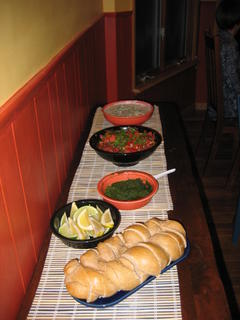
We celebrated the return of our friend Heather, to the US after spending the summer at a university in Beirut, learning Arabic in an intensive language course. We also celebrated Morganna’s homecoming as well; she has officially moved into our home from her father’s, and will be starting school here in Ohio in the fall.
Heather asked, through Dan, before she made it home, that I cook either Indian or Chinese and something spicy, as she found Lebanese food, while delicious and satisfying, to be less spicy than she preferred.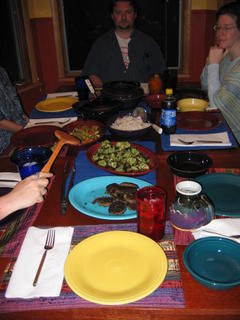
Let me talk a bit about the structure of a typical Northern Indian dinner; everything I prepared for the celebratory feast was from the culinary traditions of the northern parts of the Indian subcontinent. In large part, that is because most of my exposure to Indian foods has come about from my interactions in Indian restaurants in the states, most of which serve Northern Indian cuisine, and also because my Indian friends and clients have all been northerners.
Indian meals are built around a grain product; either rice or some sort of bread. Sometimes both are served at a meal, but that is rare. I broke with tradition and served both a basmati rice pillau with golden raisins and almonds, and some bread, which was an even larger break with tradition, it being challah, a Jewish braided egg-bread, as opposed to naan, chapati or roti. I just happened to have a piece of very excellent bread from a local bakery pressed into my hands to try at the farmer’s market and decided to take some home, determining it would mean that I didn’t have to bake, griddle or fry any bread for that night.
There is nearly always a dal, or legume dish on the menu of a typical Indian meal. I once again broke from tradition by not featuring any bean or lentil based dishes, in large part, because I had a lot of fresh vegetables to use up in the meal and I wanted to make sure and use them in preference to any dried beans. If I had a few more diners coming, I would have presented either channa masala or perhaps some variant on my beloved masoor dal tarka. (I adore that dish.)
Various vegetable dishes are also served. On Saturday, because of the abundance of local eggplant I had (Somewhere along the lines of about a dozen), I decided on baigan bartha; I had just picked up a quart of blue new potatoes from our CSA, so I served saag aloo. (Besides, Tom–pictured at the head of the table– was coming, and since the only Indian food he has eaten has been what I have cooked and he adored saag aloo so much the first time he had it, I wanted to serve it again just for him.)
Then, there are the cold dishes–accompianments. A lot of Americans will leave these dishes out, but while at the market, I had mentioned I was cooking Indian food to a woman who is married to a wonderful man from the subcontinent, and that was the second question she asked me–what cold salads was I serving?
Raita is a natural; it is a yogurt based dish that can be used as a sauce with a main course, as an appetizer, a soup, a side dish, or for a light breakfast or lunch. I served a cucumber, tomato and mint raita made with whole milk yogurt, though I am also partial to potato raitas as well. I just thought that a second potato dish would be too much.
I also served a fresh tomato salad and utilized the lovely, richly flavored heirloom tomatoes which have weighed down my market bags recently. I love Indian salads; they are an excercise in contrasting flavors, colors and textures, and they are so refreshing when eaten next to warm dishes or eaten along with meats.
Finally, I also presented green chutney, which is a finely ground mixture of cilantro, onion, mint, spices and lemon juice, to which I added finely diced red onion for a contrast in color and texture.
The meat dishes, which are not necessary to a balanced Indian meal if a dal is served, were three very different than the usual sauce-laden meat curries. I served the sindhi murgh elaichi–green tandoori style chicken— which I served at the dinner where we said goodbye to Heather earlier this summer, which allowed us to use the charcoal grill to cook outside, thus reducing the heat of the kitchen to some extent. Also cooked on the grill were chappli kebab, a minced lamb patty that I first read about in Madhur Jaffrey’s little book, Quick and Easy Indian Cooking. Finally, I used cubes of lamb shoulder meat to make bohti gosht–which translates as “meat cubes.” Another dish I first learned from that same Madhur Jaffrey book, but which, over the years, I have changed to suit my own taste. It is cooked in the pressure cooker, and results in very moist, tender unsauced meat where the spice paste clings tightly to the cubes.
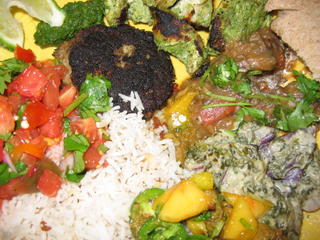
It is a simple dish which is perfect for a dinner after a busy day; you can prepare the spiced meat the day before or that morning and shape and cook the patties that night, either in an oiled pan on on the grill.
Chappli Kebab
Ingredients:
2 tablespoons chickpea flour (called gram or besan at the Indian market)
1 pound finely ground lamb
1/4 cup finely chopped cilantro
1 fresh Thai bird chile., stem removed
1 1/2 teaspoons cumin seeds, toasted
1 1/2 teaspoons coriander seeds, toasted
1 teaspoon white peppercorns
contents of one green cardamom pod, husk removed
1 teaspoon salt
1 small lightly beaten egg
Method:
Put chickpea flour and meat into a medium sized bowl. Grind together finely the remaining ingredients save the egg. Add spice mixture and egg to bowl, and then using your hands, mix together well.
Cover and refrigerate for at least three hours.
Remove from fridge, form into eight patties, and either grill or fry in an oiled cast iron skillet until they are done to your taste. Take care in turning them over as they are very fragile, and will form a bit of a crust on the outside that is delicious.
Note: They got a bit more done on the outside than I prefer, (Zak was grilling in the dark and was having a hard time seeing how done anything was) though it didn’t really affect their eatability–everyone really enjoyed them, especially topped with the green chutney or dipped in the raita.
Local Eating Update:
The main components of the afformentioned meal: the lamb, chicken, vegetables, fruits, butter and eggs were all local.
The rice was Indian basmati, the spices were bought at the local Penzey’s store in Columbus, though of course, they were grown all over the world, and the yogurt was from Vermont.
I am thinking of picking up more of the Hartzler’s milk the next time we are in Columbus, some for drinking and some so I can try my hand at making my own yogurt. If I can get a good starter going, I may just make my own yogurt as a matter of course. It will be my first step in trying my hand at cheesemaking, yet another long-term culinary project for me to undertake.
Better Late Than Never Weekend Cat Blogging…
 And so it is that I am late for this weekend’s edition of Cat Blogging.
And so it is that I am late for this weekend’s edition of Cat Blogging.
I was so busy yesterday preparing a feast of Indian food (and yes, yes, there will be posts all about that soon) to celebrate the return home of Heather from her sojourn in Beirut, and my daughter Morganna, that I forgot completely that I should be posting wonderful kitty pictures here for everyone to see.
How neglectful of me. How wretched, evil and awful.
Especially since we have a new member to our household.
Yes.
Morganna has a kitten. His name is Indrid, and he came from a cat rescue association in Columbus, Ohio. He is half Siamese and half tabby/white domestic shorthair, and all cuteness.
As you can see.
Here he is sleeping in his bed, which is a shoebox with a towel and some of Morganna’s old t-shirts and a teddy bear. And yes, he sleeps in it of his own volition, and cuddles with the bear. It is kind of gross, he is so cute.
He is twelve weeks old, and has already captured Gummitch’s heart, and is well on his way to getting Grimalkin’s, too. Minna, well, for her, she is well-behaved and is showing great curiosity and fortitute. Ozy–he’s seen so many kittens in his time, nothing startles him anymore. Neither Jack nor Tristan have met him yet, so they are without opinion on the issue.
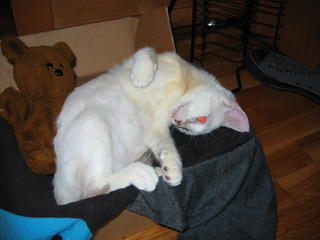 Of course, Morganna and Zak and I are charmed.
Of course, Morganna and Zak and I are charmed.
I guess we will never lack for photogenic cats in this family.
What I find to be really adorable about this guy is that he will fight sleep. He will crawl up into his bed, and curl into a ball, and then his eyes will close, and suddenly, he will wiggle, and roll, like you see over there on the right, and bat at nothing, just to wake himself up.
Just like a toddler who doesn’t want to go to bed, because he might miss something interesting that the adults are doing.
Powered by WordPress. Graphics by Zak Kramer.
Design update by Daniel Trout.
Entries and comments feeds.


